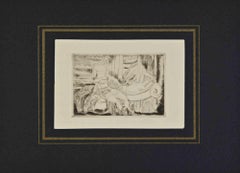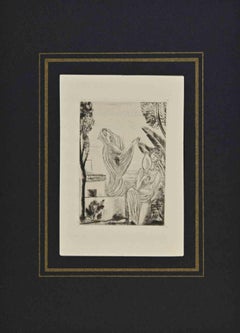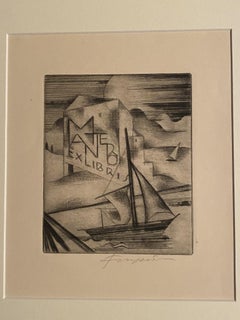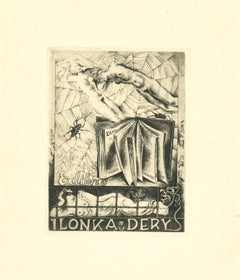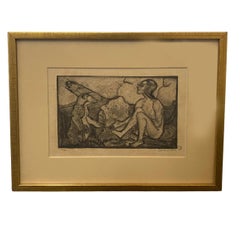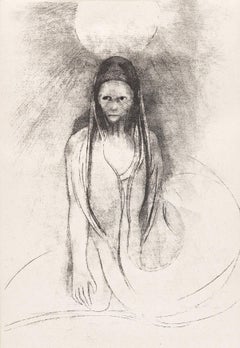Symbolist Figurative Prints
to
137
413
26
72
1
2
Overall Width
to
Overall Height
to
15,569
8,001
2,621
2,435
2,253
1,000
944
735
667
408
323
112
93
37
96
38
36
34
33
2
77
436
1
11
94
92
82
7
4
2
2
6
3
368
140
5
363
222
176
107
97
79
69
35
31
29
27
25
24
18
17
15
12
12
11
11
198
108
98
84
55
25
306
306
101
Style: Symbolist
Lovers - Etching by André Suares - 1926
Located in Roma, IT
Lovers is from Illustrations for Cressidra, a print on paper realized by André Suares in 1926.
Etching and drypoint
Edition of 200 print, Including a Passepartout
Good conditions.
Category
1920s Symbolist Figurative Prints
Materials
Etching
Ladies - Etching by André Suares - 1926
Located in Roma, IT
Ladies is from Illustrations for Cressidra, a print on paper realized by André Suares in 1926.
Etching and drypoint
Edition of 200 print, Including a Passepartout
Good conditions.
Category
1920s Symbolist Figurative Prints
Materials
Etching
Ex Libris - Etching by Michel Fingesten - 1930s
Located in Roma, IT
"Ex Libris" is an Etching, Ex Libris, on ivory-colorated paper by Michel Fingesten .
In excellent conditions: As good as new.
Hand-signed in pencil, on the lower right.
Michel Fin...
Category
1930s Symbolist Figurative Prints
Materials
Etching
Ex Libris - Etching by Michel Fingesten - 1930s
Located in Roma, IT
"Ex Libris" is an Etching, Ex Libris, on ivory-colorated paper by Michel Fingesten .
In excellent conditions: As good as new.
Not signed.
Michel Fingesten (1884 - 1943) was a Czec...
Category
1930s Symbolist Figurative Prints
Materials
Etching
"Jungle Law" Black and White Lithograph by Orovida Camille Pissarro 14/45
Located in Pasadena, CA
This black-and-white lithograph, numbered 14/45, is the work of Orovida, whose real name is Camille Orovida Pissarro. The rectangular framing tightens the composition around three fi...
Category
Mid-20th Century Symbolist Figurative Prints
Materials
Lithograph
L'Intelligence fut a moi! Je devins le Buddha
By Odilon Redon
Located in New York, NY
A very good impression of this lithograph on Chine appliqué. Edition of 50. Printed by Blanchard, Paris. Published by Vollard, Paris. From "La Tentation de Saint-Antoine (Troisième s...
Category
1890s Symbolist Figurative Prints
Materials
Lithograph
Opus IV Unter den Soldaten Rad - Etching by Max Klinger - 1881
By Max Klinger
Located in Roma, IT
Opus IV Unter den Soldaten Rad belongs to a series of prints called Intermezzi realized by Max Klinger, published by Nurnberg: Stroefer, 1881.
Etching on paper.
Signed on the plate...
Category
1880s Symbolist Figurative Prints
Materials
Etching
Fallen Rider from Intermezzi - Etching by Max Klinger - 1881
By Max Klinger
Located in Roma, IT
Fallen Rider from Intermezzi belongs to a series of prints called Intermezzi realized by Max Klinger, published by Nurnberg: Stroefer, 1881.
Etching on paper.
Signed on the plate
...
Category
1880s Symbolist Figurative Prints
Materials
Etching
Green Sphinx Etching by John Marx
Located in Pasadena, CA
In this polychrome etching, signed with his initials in pencil, John Marx constructs a scene that oscillates between strangeness and collective introspection. The winged, sphinx-like...
Category
Late 20th Century Symbolist Figurative Prints
Materials
Etching
Ex Libris - Istvan Traurig - Etching by Michel Fingesten - 1930s
Located in Roma, IT
Ex Libris - Istvan Traurig is a Woodcut print created by Michel Fingesten.
Signed on plate on back. The work is glued on cardboard.
Total dimensions: cm 32x24
Good conditions.
...
Category
1930s Symbolist Figurative Prints
Materials
Etching
$320 Sale Price
20% Off
Ex Libris - Mantero- Etching by Michel Fingesten - 1930s
Located in Roma, IT
Ex Libris - Mantero is an Etching print created by Michel Fingesten.
Hand Signed on the right margin.
Good conditions.
Michel Fingesten (1884 - 1943) was a Czech painter and eng...
Category
1930s Symbolist Figurative Prints
Materials
Etching
$339 Sale Price
40% Off
Ex Libris - Mary Talbot - Etching by Michel Fingesten - 1930s
Located in Roma, IT
Ex Libris - Mary Talbot is an Etching print created by Michel Fingesten.
Hand Signed on the lower right margin.
Good conditions.
Michel Fingesten (1884 - 1943) was a Czech painte...
Category
1930s Symbolist Figurative Prints
Materials
Etching
$453 Sale Price
20% Off
Ex Libris L'Amour et la Folie - Ex Libris - Woodcut by Michel Fingesten - 1930s
Located in Roma, IT
Ex Libris L'Amour et la Folie - Ex Libris Jean Brissac is a woodcut print created by Michel Fingesten.
Hand Signed on the lower right margin.
Good conditions.
Michel Fingesten (...
Category
1930s Symbolist Figurative Prints
Materials
Woodcut
Ex Libris - Woodcut by Michel Fingesten - 1930s
Located in Roma, IT
Ex Libris is a colored woodcut print created by Michel Fingesten.
Hand Signed on the upper margin.
Good conditions.
Michel Fingesten (1884 - 1943) was a Czech painter and engrav...
Category
1930s Symbolist Figurative Prints
Materials
Woodcut
$415 Sale Price
20% Off
Ex Libris - Eroticis M.B. - Woodcut by Michel Fingesten - 1930s
Located in Roma, IT
Ex Libris - Eroticis M.B. is a colored woodcut print created by Michel Fingesten.
Hand Signed on the lower right margin.
Good conditions.
Michel Fingesten (1884 - 1943) was a C...
Category
1930s Symbolist Figurative Prints
Materials
Woodcut
$377 Sale Price
20% Off
Ex Libris - Reinheime - Woodcut by Michel Fingesten - 1930s
Located in Roma, IT
Ex Libris - Reinheimer is a colored woodcut print created by Michel Fingesten.
Hand Signed on the lower right margin.
Good conditions.
Michel Fingesten (1884 - 1943) was a Czec...
Category
1930s Symbolist Figurative Prints
Materials
Woodcut
$415 Sale Price
20% Off
Ex Libris - Livio Ghislandi - Woodcut by Michel Fingesten - 1930s
Located in Roma, IT
Ex Libris - Livio Ghislandi is a woodcut print created by Michel Fingesten.
Hand Signed on the lower right margin.
Good conditions.
Michel Fingesten (1884 - 1943) was a Czech ...
Category
1930s Symbolist Figurative Prints
Materials
Woodcut
Ex Libris - Salve Pax - Woodcut by Michel Fingesten - 1937
Located in Roma, IT
Ex Libris - Salve Pax is a woodcut print created by Michel Fingesten in 1937.
Hand Signed on the lower right margin.
Good conditions.
Michel Fingesten (1884 - 1943) was a Czech...
Category
1930s Symbolist Figurative Prints
Materials
Woodcut
Ex Libris - Woodcut by Michel Fingesten - 1930s
Located in Roma, IT
Ex Libris is a woodcut print created by Michel Fingesten in 1937.
Hand Signed on the lower right margin.
Good conditions.
Michel Fingesten (1884 - 1943) was a Czech painter an...
Category
1930s Symbolist Figurative Prints
Materials
Woodcut
Ex Libris - Malz - Woodcut by Michel Fingesten - 1930s
Located in Roma, IT
Ex Libris - Malz- is a colored woodcut print created by Michel Fingesten, in 1936.
Hand Signed on the lower right margin.
Good conditions.
Michel Fingesten (1884 - 1943) was a...
Category
1930s Symbolist Figurative Prints
Materials
Woodcut
$377 Sale Price
20% Off
Ex Libris Ruter - Woodcut by Michel Fingesten - 1939
Located in Roma, IT
Ex Libris - Ruter is a Woodcut print created by Michel Fingesten.
Hand Signed on the lower right margin. Numbered on the left corner, ex. n. 6/30
Very good condition.
Michel Fing...
Category
1930s Symbolist Figurative Prints
Materials
Woodcut
$358 Sale Price
20% Off
Ex Libris et Musicis Mantero - Etching by Michel Fingesten - 1930s
Located in Roma, IT
Ex Libris et Musicis Mantero is an Etching print created by Michel Fingesten.
Hand Signed on the right margin.
Very good condition.
Michel Fingesten (1884 - 1943) was a Czech pa...
Category
1930s Symbolist Figurative Prints
Materials
Etching
Ex Libris - Prof. Dr. Rudolf Voon Soo - Etching by Michel Fingesten - 1930s
Located in Roma, IT
Ex Libris - Prof. Dr. Rudolf Voon Soo is an Etching print created by Michel Fingesten.
Hand Signed on the lower right margin.
Very good condition.
Michel Fingesten (1884 - 1943) w...
Category
1930s Symbolist Figurative Prints
Materials
Etching
Ex Libris Gianni Gheri - Etching by Michel Fingesten - 1930s
Located in Roma, IT
Ex Libris - Gianni Gheri is an Etching print created by Michel Fingesten.
Hand Signed on the lower right margin.
Very good condition.
Michel Fingesten (1884 - 1943) was a Czech p...
Category
1930s Symbolist Figurative Prints
Materials
Etching
$547 Sale Price
20% Off
Ex Libris - Mantero - Woodcut by Michel Fingesten - 1930s
Located in Roma, IT
Ex Libris - Mantero is a Woodcut print created by Michel Fingesten.
Hand Signed on the lower right margin.
Very Good condition.
Michel Fingesten (1884 - 1943) was a Czech painter...
Category
1930s Symbolist Figurative Prints
Materials
Woodcut
$358 Sale Price
20% Off
Ex Libris - Robert Malz - Woodcut by Michel Fingesten - 1930s
Located in Roma, IT
Ex Libris - Robert Malz is a colored Woodcut print created by Michel Fingesten.
Hand Signed on the lower right margin.
Very Good condition..
Michel Fingesten (1884 - 1943) was a ...
Category
1930s Symbolist Figurative Prints
Materials
Woodcut
$358 Sale Price
20% Off
Ex Libris - Sabattini - Etching by Michel Fingesten - 1930s
Located in Roma, IT
Ex Libris - Sabattini is an Etching print created by Michel Fingesten.
Hand Signed on the lower right margin.
Very Good conditions.
Michel Fingesten (1884 - 1943) was a Czech pai...
Category
1930s Symbolist Figurative Prints
Materials
Etching
$453 Sale Price
20% Off
Ex Libris - Gianni Mantero - Etching by Michel Fingesten - 1930s
Located in Roma, IT
Ex Libris - Gianni Mantero is an Etching print created by Michel Fingesten.
Hand Signed on the lower right margin.
Very Good conditions.
Michel Fingesten (1884 - 1943) was a Czec...
Category
1930s Symbolist Figurative Prints
Materials
Etching
$462 Sale Price
20% Off
Ex Libris - Eug. Strens - Etching by Michel Fingesten - 1939
Located in Roma, IT
Ex Libris - Eug. Strens is an Etching print created by Michel Fingesten in 1939.
Hand Signed on the lower right margin.
Very Good conditions.
Michel Fingesten (1884 - 1943) was a...
Category
1930s Symbolist Figurative Prints
Materials
Etching
$528 Sale Price
20% Off
Ex Libris - R. A. - woodcut by Michel Fingesten - 1930s
Located in Roma, IT
Ex Libris - R.A. is a Woodcut print created by Michel Fingesten.
Hand signed on the lower margin.
Good conditions.
Michel Fingesten (1884 - 1943) was a Czech painter and engraver ...
Category
1930s Symbolist Figurative Prints
Materials
Woodcut
$283 Sale Price
20% Off
Ex Libris - Kurt Hermann Mendel - Woodcut by Michel Fingesten - 1936
Located in Roma, IT
Ex Libris - Kurt Hermann Mendel is a Woodcut print created by Michel Fingesten in 1936.
Hand signed on the lower margin.
Good conditions.
Michel Fingesten (1884 - 1943) was a Cze...
Category
1930s Symbolist Figurative Prints
Materials
Woodcut
$424 Sale Price
20% Off
Ex Libris - Gino Sabattini - Etching by Michel Fingesten - 1930s
Located in Roma, IT
Ex Libris - Gino Sabattini is an Etching print created by Michel Fingesten.
Hand Signed in the lower right margin.
Good conditions except some foxings that doesn't affect the image...
Category
1930s Symbolist Figurative Prints
Materials
Etching
$472 Sale Price
20% Off
Ex Libris - Negreanu - Etching by Michel Fingesten - 1930s
Located in Roma, IT
Ex Libris - Negreanu is an Etching print created by Michel Fingesten.
Monogrammed on plate on the right margin.
Good conditions.
Michel Fingesten (1884 - 1943) was a Czech painte...
Category
1930s Symbolist Figurative Prints
Materials
Etching
$519 Sale Price
20% Off
Ex Libris - H. Malz Wünscht - Etching by Michel Fingesten - 1936
Located in Roma, IT
Ex Libris - H. Malz Wünscht is a Woodcut print created by Michel Fingesten in 1936.
Hand signed on the lower margin.
Good conditions.
Michel Fingesten (1884 - 1943) was a Czech pa...
Category
1930s Symbolist Figurative Prints
Materials
Etching
$377 Sale Price
20% Off
Ex Libris - Violette Talbot - Etching by Michel Fingesten - 1930s
Located in Roma, IT
Ex Libris - Violette Talbot is an Etching print created by Michel Fingesten.
Hand signed on the lower margin.
Good conditions.
Michel Fingesten (1884 - 1943) was a Czech painter ...
Category
1930s Symbolist Figurative Prints
Materials
Etching
$318 Sale Price
40% Off
Ex Libris - Benito Mussolini - Etching by Michel Fingesten - 1930s
Located in Roma, IT
Ex Libris - Benito Mussolini is an Etching print created by Michel Fingesten.
Hand signed on the lower margin.
Good conditions.
Michel Fingesten (1884 - 1943) was a Czech painter...
Category
1930s Symbolist Figurative Prints
Materials
Etching
Ex Libris - Gabriele D'Annunzio - Etching by Michel Fingesten - 1930s
Located in Roma, IT
Ex Libris - Gabriele D'Annunzio is an Etching print created by Michel Fingesten in 1936.
Hand signed on the lower margin.
Good conditions.
Michel Fingesten (1884 - 1943) was a Cz...
Category
1930s Symbolist Figurative Prints
Materials
Etching
Ex Libris - Gaston Roux - Etching by Michel Fingesten - 1930s
Located in Roma, IT
Ex Libris - Gaston Roux is an Etching print created by Michel Fingesten.
Hand signed on the lower margin.
Good conditions.
Michel Fingesten (1884 - 1943) was a Czech painter and ...
Category
1930s Symbolist Figurative Prints
Materials
Etching
$339 Sale Price
40% Off
Ex Libris Fernando Alb. Junior Marques Figueira Da Foz-Woodcut-Mid 20th Century
Located in Roma, IT
Ex Libris Fernando Alb. Junior Marques Figueira Da Foz is a Modern Artwork realized in Mid 20th Century.
Ex Libris. Coloured woodcut on paper.
The work is glued on cardboard.
...
Category
Mid-20th Century Symbolist Figurative Prints
Materials
Woodcut
Ex Libris W.G.Zwolle - Woodcut - 1940
Located in Roma, IT
Ex Libris W.G.Zwolle is an Artwork realized in 1940.
Woodcut B./W. print on ivory paper. The work is glued on cardboard.
Total dimensions: 20 x 14 cm.
Good conditions.
The artwo...
Category
1940s Symbolist Figurative Prints
Materials
Woodcut
$113 Sale Price
40% Off
Ex Libris - Dr. Nicolàs Leòn - Woodcut - Mid 20th Century
Located in Roma, IT
Ex Libris - Dr. Nicolàs Leòn is a Modern Artwork realized in Mid 20th Century
B/W woodcut on paper.
The work is glued on ivory cardboard.
Total dimensions: 21x 14.5 cm.
Exce...
Category
Mid-20th Century Symbolist Figurative Prints
Materials
Woodcut
$127 Sale Price
40% Off
Ex Libris - Monique Van Paeschen - Woodcut by Linda Ruttelinck - 1982
Located in Roma, IT
Ex Libris - Monique Van Paeschen is a Modern Artwork realized in 1982 s., by Linda Ruttelinck.
B/W woodcut on paper.
The work is glued on grey cardboard.
Total dimensions: 20x...
Category
1980s Symbolist Figurative Prints
Materials
Woodcut
Ex Libris -I. Volders - Woodcut - Mid-20th century
Located in Roma, IT
Ex Libris -I. Volders is a Modern Artwork realized in Mid 20th Century.
B/W woodcut on paper.
The work is glued on cardboard.
Total dimensions: 20x 15 cm.
Excellent conditions...
Category
Mid-20th Century Symbolist Figurative Prints
Materials
Woodcut
Ex Libris - Schult - Woodcut - 1982
Located in Roma, IT
Ex Libris - Schult is a Modern Artwork realized in 1982 s by the graphic artist Zbigniew Józwik (1937).
B/W woodcut on paper. Signed on plate on back
The work is glued on cardboa...
Category
Mid-20th Century Symbolist Figurative Prints
Materials
Woodcut
$106 Sale Price
40% Off
Ex Libris - Esperanza Rufino Tur - Woodcut - 20th Century
Located in Roma, IT
Ex Libris - Esperanza Rufino Tur is a Modern Artwork realized in 20th century .
B/W woodcut on green paper.
The work is glued on cardboard.
Total dimensions: 21x 13 cm.
Excell...
Category
20th Century Symbolist Figurative Prints
Materials
Woodcut
Ex Libris - Ibuena Caza! Carlos F Porter - Woodcut - 1949
Located in Roma, IT
Ex Libris - Ibuena Caza! Carlos F Porter is a Modern Artwork realized in 1949.
B/W woodcut on ivory paper.
The work is glued on cardboard.
Total dimensions: 21x 15 cm.
Excelle...
Category
1940s Symbolist Figurative Prints
Materials
Woodcut
Ex Libris - Dr Enrique Saez - Woodcut - Mid 20th Century
Located in Roma, IT
Ex Libris - Dr Enrique Saez is a Modern Artwork realized in Mid 20th Century
B/W woodcut on paper.
The work is glued on cardboard.
Total dimensions: 21x 15 cm.
Good conditi...
Category
Mid-20th Century Symbolist Figurative Prints
Materials
Woodcut
$141 Sale Price
40% Off
Ex Libris - Piet Van Veen - Woodcut - Mid 20th Century
Located in Roma, IT
Ex Libris - Piet Van Veen is a Modern Artwork realized in Mid 20th Century
B/W woodcut on ivory paper.
The work is glued on cardboard.
Total dimension...
Category
Mid-20th Century Symbolist Figurative Prints
Materials
Woodcut
$106 Sale Price
40% Off
Ex Libris - Maria Van Der Meer - Woodcut - Mid-20th century
Located in Roma, IT
Ex Libris -Maria Van Der Meer is a Modern Artwork realized in Mid 20th Century.
Ex Libris. B/W woodcut on paper.
The work is glued on cardboard.
Total dimensions: 20x 14.5 cm.
...
Category
Mid-20th Century Symbolist Figurative Prints
Materials
Woodcut
$113 Sale Price
40% Off
Ex Libris -Inter Folia Fructus. G.J.H. Hendriks - Woodcut - Mid-20th century
Located in Roma, IT
Ex Libris -Inter Folia Fructus. G.J.H. Hendriks is a Modern Artwork realized in Mid 20th Century.
Ex Libris. B/W woodcut on ivory paper.
The work is glued on cardboard.
Total d...
Category
Mid-20th Century Symbolist Figurative Prints
Materials
Woodcut
Ex Libris - N. C. De Jonge - Woodcut by Antonin Dolezal - 1959
Located in Roma, IT
Ex Libris - N. C. De Jonge is a Modern Artwork realized in 1959 s. by the Czech author Antonin Dolezal (20 gennaio 1929)
B/W woodcut on paper. Hand Signed ...
Category
Mid-20th Century Symbolist Figurative Prints
Materials
Woodcut
Ex Libris - J. G. Beernink - Woodcut - 1932
Located in Roma, IT
Ex Libris - J. G. Beernink is a Modern Artwork realized in 1932 s. by J.G.(Johannes) Beernink (1878-1961)
.
Ex Libris. B/W woodcut on paper.
The work is glued on ivory cardboard....
Category
1930s Symbolist Figurative Prints
Materials
Woodcut
$113 Sale Price
40% Off
Ex Libris - Boek Van Corry Zaat - Woodcut - 1934
Located in Roma, IT
Ex Libris - Boek Van Corry Zaat is a Modern Artwork realized in 1934.
Ex Libris. B/W woodcut on paper.
The work is glued on ivory cardboard.
Total dimensions: 20x 14 cm.
Excel...
Category
1930s Symbolist Figurative Prints
Materials
Woodcut
$113 Sale Price
40% Off
Ex Libris - Por minha terra. Luiz Ferreira Matias - Woodcut - Mid 20th Century
Located in Roma, IT
Ex Libris - Por minha terra. Luiz Ferreira Matias is a Modern Artwork realized in Mid 20th Century
Ex Libris. Colored woodcut on ivory paper.
The work ...
Category
Mid-20th Century Symbolist Figurative Prints
Materials
Woodcut
Ex Libris - Adeline De Jonghe - Woodcut - Mid 20th Century
Located in Roma, IT
Ex Libris - Louis Burgers is a Modern Artwork realized in Mid-20th Century.
Ex Libris. B/W woodcut on paper.
The work is glued on grey cardboard.
Total dimensions: 20x 15 cm....
Category
Mid-20th Century Symbolist Figurative Prints
Materials
Woodcut
$113 Sale Price
40% Off
Ex Libris - Burgers - Woodcut - Mid 20th Century
Located in Roma, IT
Ex Libris - Burgers is a Modern Artwork realized in Mid-20th Century.
Ex Libris. B/W woodcut on tissue paper.
The work is glued on cardboard.
Total dimensions: 20x 15 cm.
Goo...
Category
Mid-20th Century Symbolist Figurative Prints
Materials
Woodcut
$127 Sale Price
40% Off
Ex Libris Wim Hoogendam - Woodcut - Mid 20th Century
Located in Roma, IT
Ex Libris - Wim Hoogendam is a Modern Artwork realized in mid 20th Century.
B/W woodcut on paper.
The work is glued on cardboard.
Total dimensions: 20 x 15 cm.
Mint condit...
Category
Mid-20th Century Symbolist Figurative Prints
Materials
Woodcut
$127 Sale Price
40% Off
Ex Libris Bert-Smit - Woodcut - Mid 20th Century
Located in Roma, IT
Ex Libris Bert-Smit is a Modern Artwork realized in mid 20th Century.
B/W woodcut on paper.
The work is glued on cardboard.
Total dimensions: 20.5 x 14 cm.
Good conditions....
Category
Mid-20th Century Symbolist Figurative Prints
Materials
Woodcut
$127 Sale Price
40% Off
Ex Libris Biblioteca Cadeia Comarca de Beja - Woodcut Print - Mid-20th Century
Located in Roma, IT
Ex Libris Biblioteca Cadeia Comarca de Beja is an Artwork, woodcut print on paper. The work is glued on cardboard.
Total dimensions: 21 x 15.5 cm.
The artwork represents an elegan...
Category
Mid-20th Century Symbolist Figurative Prints
Materials
Woodcut
Ex Libris Imperiosa Fames - Woodcut by Jose Manuel Ballester - Mid-20th Century
Located in Roma, IT
Ex Libris Imperiosa Fames is an Artwork realized by the Spanish Artist, Jose Manuel Ballester
Woodcut print on paper. The work is glued on cardboard.
Total dimensions: 21 x 15 cm...
Category
Mid-20th Century Symbolist Figurative Prints
Materials
Woodcut
Symbolist figurative prints for sale on 1stDibs.
Find a wide variety of authentic Symbolist figurative prints available for sale on 1stDibs. Works in this style were very popular during the 21st Century and Contemporary, but contemporary artists have continued to produce works inspired by this movement. If you’re looking to add figurative prints created in this style to introduce contrast in an otherwise neutral space in your home, the works available on 1stDibs include elements of blue, orange and other colors. Many Pop art paintings were created by popular artists on 1stDibs, including Michel Fingesten, Abel Pann, Franz von Bayros (Choisi Le Conin), and Ferdinand Hodler & R. Piper & Co.. Frequently made by artists working with Lithograph, and Woodcut Print and other materials, all of these pieces for sale are unique and have attracted attention over the years. Not every interior allows for large Symbolist figurative prints, so small editions measuring 1.58 inches across are also available. Prices for figurative prints made by famous or emerging artists can differ depending on medium, time period and other attributes. On 1stDibs, the price for these items starts at $55 and tops out at $378,675, while the average work sells for $436.
Recently Viewed
View AllMore Ways To Browse
Edward Simmons
Edwin Lord Weeks
Elizabeth Enders
Elizabeth Horning
Emil Holzhauer
England Church Oil Painting
English Deer Painting
English Fox Hunt Painting
English Toy Terrier
Enrique Martinez Celaya
Eric Aho
Eritrea Art
Ernest Chateignon
Erotic Art Animal
Eugene Chigot
Eugene Devaud De Madelin
Eugene Jardin
Faith Sheppard
